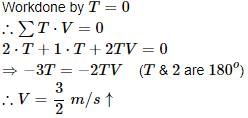All Exams >
JAMB >
Physics for JAMB >
All Questions
All questions of Newton's Laws of Motion for JAMB Exam
The dimensional formula of momentum is- a)[M L-1 T-1]
- b)[M L T-1]
- c)[ML-2T-1]
- d)[M L2 T-1]
Correct answer is option 'B'. Can you explain this answer?
The dimensional formula of momentum is
a)
[M L-1 T-1]
b)
[M L T-1]
c)
[ML-2T-1]
d)
[M L2 T-1]
|
|
Suresh Iyer answered |
Planck's Constant (h) = 6.626176 x 10-34 m2 kg/s
So, Unit of planck constant= m2 kg/s
So, Unit of planck constant= m2 kg/s
Dimensions =M L2 T −1 ________ (1)
Angular momentum l = mvr
Where, m-mass
v-velocity
r-radius
Dimensions of angular momentum = M L T −1 L = M L2 T −1 _______________ (2)
From (1) and (2).
From (1) and (2).
Planck's constant and angular momentum have the same dimensions.
How is inertia used when riding a bicycle?- a)Bicycles don’t use inertia.
- b)You can stop paddling and still continue rolling forward.
- c)You must paddle harder when going up hill.
- d)You must paddle slower when going up hill.
Correct answer is option 'B'. Can you explain this answer?
How is inertia used when riding a bicycle?
a)
Bicycles don’t use inertia.
b)
You can stop paddling and still continue rolling forward.
c)
You must paddle harder when going up hill.
d)
You must paddle slower when going up hill.
|
|
Suresh Iyer answered |
Due to inertia, even if we stop paddling of motion, we will continue to move forward up to a certain distance as friction will finally make us stop.
The dimensional formula for impulse is- a)[MLT-1]
- b)[ML2T-1]
- c)[M2LT]
- d)[ML-1T2]
Correct answer is option 'A'. Can you explain this answer?
The dimensional formula for impulse is
a)
[MLT-1]
b)
[ML2T-1]
c)
[M2LT]
d)
[ML-1T2]
|
|
Krishna Iyer answered |
We know that I = P, where P is momentum
As subtracting initial momentum from the final momentum won't affect its unit, we get unit if I is the same as that of P.
As subtracting initial momentum from the final momentum won't affect its unit, we get unit if I is the same as that of P.
Two masses are in the ratio 1:5. What is ratio of their inertia?- a)1:5
- b)5:1
- c)1:25
- d)25:1
Correct answer is option 'A'. Can you explain this answer?
Two masses are in the ratio 1:5. What is ratio of their inertia?
a)
1:5
b)
5:1
c)
1:25
d)
25:1
|
|
Sagar Goyal answered |
Force of inertia = ma
Let the masses be 1x and 5x
Force of inertia for 1st body= 1x * a
Force of inertia for 2nd = 5x * a
Ratio= x * a / 5x * a = 1:5
In the above questions what is the weight of the suspended block ?- a)
 N
N - b)
 N
N - c)
 N
N - d)
 N
N
Correct answer is option 'A'. Can you explain this answer?
In the above questions what is the weight of the suspended block ?
a)
b)
c)
d)
|
|
Gaurav Kumar answered |
The question is incomplete and is too vague to be found
It should be removed so as to not cause confusion.
It should be removed so as to not cause confusion.
Two bodies of mass 4 kg and 6 kg are attached to the ends of a string passing over a pulley. A 4 kg mass is attached to the table top by another string. The tension in this string T1 is equal to (g = 10 m/s2) 
- a)20 N
- b)25 N
- c)15 N
- d)10 N
Correct answer is option 'A'. Can you explain this answer?
Two bodies of mass 4 kg and 6 kg are attached to the ends of a string passing over a pulley. A 4 kg mass is attached to the table top by another string. The tension in this string T1 is equal to (g = 10 m/s2)
a)
20 N
b)
25 N
c)
15 N
d)
10 N

|
Mohit Rajpoot answered |
Which law is in control of a spacecraft that cruises through space at a constant speed without using any fuel?- a)Universal law of gravitation
- b)Newton’s third law
- c)Newton’s second law
- d)Newton’s first law
Correct answer is 'D'. Can you explain this answer?
Which law is in control of a spacecraft that cruises through space at a constant speed without using any fuel?
a)
Universal law of gravitation
b)
Newton’s third law
c)
Newton’s second law
d)
Newton’s first law
|
|
Rajveer Kumar answered |
Given information:
- Mass of the object = 6 kg
- Three forces acting on the object:
- F1 = 20i + 30j N
- F2 = 8i - 50j N
- F3 = 2i + 2j N
To find: Acceleration of the object
Solution:
- We know that the net force acting on the object, F_net = F1 + F2 + F3
- Using vector addition, we can find the net force: F_net = (20+8+2)i + (30-50+2)j = 30i - 18j N
- Now, using Newton's second law of motion, F_net = m*a, where m is the mass of the object and a is the acceleration produced.
- Substituting the values, we get: 30i - 18j = 6*a
- Dividing both sides by 6, we get: a = (30/6)i - (18/6)j = 5i - 3j m/s^2
Therefore, the acceleration of the object is 5i - 3j m/s^2, which is option 'B'.
- Mass of the object = 6 kg
- Three forces acting on the object:
- F1 = 20i + 30j N
- F2 = 8i - 50j N
- F3 = 2i + 2j N
To find: Acceleration of the object
Solution:
- We know that the net force acting on the object, F_net = F1 + F2 + F3
- Using vector addition, we can find the net force: F_net = (20+8+2)i + (30-50+2)j = 30i - 18j N
- Now, using Newton's second law of motion, F_net = m*a, where m is the mass of the object and a is the acceleration produced.
- Substituting the values, we get: 30i - 18j = 6*a
- Dividing both sides by 6, we get: a = (30/6)i - (18/6)j = 5i - 3j m/s^2
Therefore, the acceleration of the object is 5i - 3j m/s^2, which is option 'B'.
Three forces  act on an object of mass m = 2 kg. The acceleration of the object in m/s2 is:
act on an object of mass m = 2 kg. The acceleration of the object in m/s2 is:
- a)

- b)

- c)

- d)

Correct answer is option 'C'. Can you explain this answer?
Three forces  act on an object of mass m = 2 kg. The acceleration of the object in m/s2 is:
act on an object of mass m = 2 kg. The acceleration of the object in m/s2 is:
 act on an object of mass m = 2 kg. The acceleration of the object in m/s2 is:
act on an object of mass m = 2 kg. The acceleration of the object in m/s2 is:a)
b)
c)
d)

|
EduRev Humanities answered |
Force vector follows the principle of superposition which says all the force vectors can be vectorially added if applied on one point to get the net force vector. Hence we get
F = F1 + F2 + F3
= (-2 + 3) i + (1 - 2) j
F = i - j = ma
Thus we get a = (i - j) /m
= (i - j) / 2
F = F1 + F2 + F3
= (-2 + 3) i + (1 - 2) j
F = i - j = ma
Thus we get a = (i - j) /m
= (i - j) / 2
Adjoining figure shows a force of 40 N acting at 30° to the horizontal on a body of mass 5 kg resting on a smooth horizontal surface. Assuming that the acceleration of free-fall is 10 ms_2, which of the following statements A, B, C, D, E is (are) correct? [1] The horizontal force acting on the body is 20 N[2] The weight of the 5 kg mass acts vertically downwards[3] The net vertical force acting on the body is 30 N
[1] The horizontal force acting on the body is 20 N[2] The weight of the 5 kg mass acts vertically downwards[3] The net vertical force acting on the body is 30 N- a)1,2,3
- b)1,2
- c)2 only
- d)1 only
Correct answer is option 'C'. Can you explain this answer?
Adjoining figure shows a force of 40 N acting at 30° to the horizontal on a body of mass 5 kg resting on a smooth horizontal surface. Assuming that the acceleration of free-fall is 10 ms_2, which of the following statements A, B, C, D, E is (are) correct?
[1] The horizontal force acting on the body is 20 N
[2] The weight of the 5 kg mass acts vertically downwards
[3] The net vertical force acting on the body is 30 N
a)
1,2,3
b)
1,2
c)
2 only
d)
1 only

|
EduRev Humanities answered |
(C) 2 only
[2] The weight of the 5kg mass acts vertically downwards
Find velocity of block 'B' at the instant shown in figure. 
- a)25 m/s
- b)20 m/s
- c) 22 m/s
- d)30 m/s
Correct answer is option 'A'. Can you explain this answer?
Find velocity of block 'B' at the instant shown in figure.
a)
25 m/s
b)
20 m/s
c)
22 m/s
d)
30 m/s
|
|
Rajesh Gupta answered |
Net Force = Force exerted by Cyclist - Frictional Force
Also, according to newton's second law
Fnet = m.a
250 N - Frictional Force = 30x4
∴ Frictional Force = 250 - 120 N
= 130 N
Also, according to newton's second law
Fnet = m.a
250 N - Frictional Force = 30x4
∴ Frictional Force = 250 - 120 N
= 130 N
In the arrangement shown in figure, pulleys are massless and frictionless and threads are inextensible. The Block of mass m1 will remain at rest, if 
- a)

- b) m1 = m2 + m3
- c)

- d)

Correct answer is option 'C'. Can you explain this answer?
In the arrangement shown in figure, pulleys are massless and frictionless and threads are inextensible. The Block of mass m1 will remain at rest, if
a)
b)
m1 = m2 + m3
c)
d)
|
|
Nandini Iyer answered |
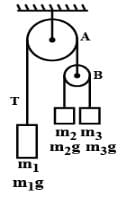
a = [(m3−m2 )/(m2+m3) ]g (m3 > m2)
T = [2m2m3g] / [m2+m3]
T′ = 2T = [4m2m3g] / [m2+m3]
m1g = 4m2m3gm / m2+m3
4/m1 = [1/m2] + [1/m3]
Two blocks are in contact on a frictionless table. One has mass m and the other 2m. A force F is applied on 2m as shown in the figure. Now the same force F is applied from the right on m. In the two cases respectively, the ratio force of contact between the two block will be :


- a) Same
- b)1 : 2
- c) 2 : 1
- d)1 : 3
Correct answer is option 'B'. Can you explain this answer?
Two blocks are in contact on a frictionless table. One has mass m and the other 2m. A force F is applied on 2m as shown in the figure. Now the same force F is applied from the right on m. In the two cases respectively, the ratio force of contact between the two block will be :
a)
Same
b)
1 : 2
c)
2 : 1
d)
1 : 3

|
Kamna Science Academy answered |
- If F is applied force then acceleration of the system is F/2m + m = F/3m
- Now when we apply the force from the left, the force applied on the block m is F/3m = F/3. This will be the force in the contact.
- When we apply the force from the right from on the block will be 2Fm/3 = 2F/3, this will be the force on the contact then.
So the ratio is F/3 : 2F/3 = 1 : 3
A bomb of mass 16kg at rest, explodes into two pieces of masses 4kg and 12kg. After explosion, the velocity of the 12kg mass is 4m/s. What is the velocity of the 4kg piece?- a)-12 m/s
- b)12 m/s
- c)-4 m/s
- d)none of these
Correct answer is option 'A'. Can you explain this answer?
A bomb of mass 16kg at rest, explodes into two pieces of masses 4kg and 12kg. After explosion, the velocity of the 12kg mass is 4m/s. What is the velocity of the 4kg piece?
a)
-12 m/s
b)
12 m/s
c)
-4 m/s
d)
none of these
|
|
Om Desai answered |
Simply by conserving the momentum of the system we get that,
0 (initial momentum) = 12 x 4 + 4 x v (final momentum)
Thus we get v = -12 m/s
0 (initial momentum) = 12 x 4 + 4 x v (final momentum)
Thus we get v = -12 m/s
Three block are connected as shown, on a horizontal frictionless table and pulled to the right with a force T3 = 60 N. If m1 = 10 kg, m2 = 20 kg and m3 = 30 kg, the tension T2 is-
- a)10 N
- b)20 N
- c)30 N
- d)60 N
Correct answer is option 'C'. Can you explain this answer?
Three block are connected as shown, on a horizontal frictionless table and pulled to the right with a force T3 = 60 N. If m1 = 10 kg, m2 = 20 kg and m3 = 30 kg, the tension T2 is-

a)
10 N
b)
20 N
c)
30 N
d)
60 N

|
Sushil Kumar answered |
Let a be the acceleration of the system.
T1 = M1a .....(1)
T2 − T1 = M2a ....(2)
F − T2 = M3a ......(3)
Adding (1), (2) and (3) we get
(M1 + M2 + M3)a = F
or (10+20+30)a = 60
⇒ a = 1m/s2
Now , T2 = (M1+M2)a
⇒ (10+20)(1) = 30N
T1 = M1a .....(1)
T2 − T1 = M2a ....(2)
F − T2 = M3a ......(3)
Adding (1), (2) and (3) we get
(M1 + M2 + M3)a = F
or (10+20+30)a = 60
⇒ a = 1m/s2
Now , T2 = (M1+M2)a
⇒ (10+20)(1) = 30N
Find out the reading of the weighing machine in the following cases. 
- a)

- b)

- c)

- d)

Correct answer is option 'A'. Can you explain this answer?
Find out the reading of the weighing machine in the following cases.
a)
b)
c)
d)
|
|
Hansa Sharma answered |
N = mgcosФ
= 2 x 10 x cos30
= 2 x 10 x √3 / 2
= 10√3 N
= 2 x 10 x cos30
= 2 x 10 x √3 / 2
= 10√3 N
A block sliding along inclined plane as shown in figure. If the acceleration of chamber is ‘a’ as shown in the figure. The time required to cover a distance L along inclined plane is 
- a)

- b)

- c)

- d)

Correct answer is option 'C'. Can you explain this answer?
A block sliding along inclined plane as shown in figure. If the acceleration of chamber is ‘a’ as shown in the figure. The time required to cover a distance L along inclined plane is
a)
b)
c)
d)
|
|
Neha Sharma answered |
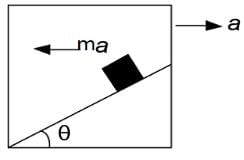
Applying pseudo force ma along the left direction of the block.
The net acceleration along the incline will be aeffective=acosθ+gsinθ
The time required will be L=0×t+½ aeffectivet2
⇒ √ 2L/ aeffective
⇒√ 2L /acosθ+gsinθ
Concept of pseudo force is valid only in- a)inertial frame
- b)Non-inertial frame
- c)can be inertial or non-inertial frame
- d)None of these
Correct answer is option 'B'. Can you explain this answer?
Concept of pseudo force is valid only in
a)
inertial frame
b)
Non-inertial frame
c)
can be inertial or non-inertial frame
d)
None of these
|
|
Rohit Shah answered |
This is because newton's laws are valid only for inertial frames. Analysis from an inertial frame isn't possible using those laws, to put it simple.
Let us assume a glass lift is going up with an acceleration 'a'. with respect to the ground. Clearly, this is a non-inertial frame as it has an acceleration. Man 'A' is inside the lift and wants to analyze the motion of the lift, but he cannot, as the newton's laws are not valid. So he takes his phone and calls Man 'B', who stands outside on the ground (in an inertial frame). This fellow watches Man 'A' go up with acceleration 'a'. Forces acting on Man 'A' are:
1. Weight, mg
2. Normal reaction offered by the lift, N
Thus, taking upward direction as positive and using Newton's Law, he writes the equation,
N - mg = ma, or
N = mg+ma
He tells "N=mg+ma" on phone to Man 'A'.
Now, Man 'A' looks around himself. According to himself, he is at rest. So, according to him, N = mg. Sadly, he knows this is not a correct analysis, as the newton's laws can't be applied!
The correct analysis, as received on phone, is N=mg+ma!
This is his eureka moment! He realizes that if he considers a "pseudo force" of magnitude 'ma' acting in opposite direction to acceleration of his frame, a correct analysis is possible!
This is why the concept of pseudo force is introduced, although it isn't necessary. You can always equate the net force in a direction equal to mass times acceleration from outside the non-inertial frame. However, if you want to do it from the non-inertial frame, the result can be interpreted in such a way, which suggests that the body is under rest, but an additional force (pseudo force) is acting.
A block is placed on the table. What is the angle between the action of the block on the table and reaction of the table on the block?
- a)90o
- b)300
- c)0o
- d)180o
Correct answer is option 'D'. Can you explain this answer?
A block is placed on the table. What is the angle between the action of the block on the table and reaction of the table on the block?
a)
90o
b)
300
c)
0o
d)
180o
|
|
Hansa Sharma answered |
According to Newton's 3 rd law, every action and reaction have same magnitude and opposite direction. So the angle between them should be 180o.
A particle moves in the xy plane under the action of a force F such that the value of its linear momentum (P) at any time t is, Px = 2 cost, Py = 2 sint. The angle q between P and F at that time t will be -- a)0º
- b)30º
- c)90º
- d)180º
Correct answer is option 'C'. Can you explain this answer?
A particle moves in the xy plane under the action of a force F such that the value of its linear momentum (P) at any time t is, Px = 2 cost, Py = 2 sint. The angle q between P and F at that time t will be -
a)
0º
b)
30º
c)
90º
d)
180º

|
Infinity Academy answered |
Fx = dpx / dt = - 2sint
Fy = dpy / dt = 2cost
So angle between F and P will be 90º because we see that their dot product is zero.
Fy = dpy / dt = 2cost
So angle between F and P will be 90º because we see that their dot product is zero.
In the arrangement shown in fig. the ends P and Q of an unstretchable string move downwards with uniform speed U. Pulleys A and B are fixed. Mass M moves upwards with a speed. 
- a)2 U cos q
- b) U cos q
- c)

- d)

Correct answer is option 'D'. Can you explain this answer?
In the arrangement shown in fig. the ends P and Q of an unstretchable string move downwards with uniform speed U. Pulleys A and B are fixed. Mass M moves upwards with a speed.
a)
2 U cos q
b)
U cos q
c)
d)
|
|
Naina Sharma answered |
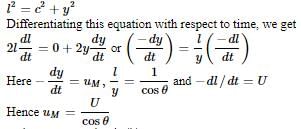
Thus option D is correct
What is the smallest radius of a circle at which a bicyclist can travel if his speed is 7 m/s and the coefficient of static friction between tyres and road is 0.25 - a)10 m
- b)20 m
- c)5 m
- d)15 m
Correct answer is option 'B'. Can you explain this answer?
What is the smallest radius of a circle at which a bicyclist can travel if his speed is 7 m/s and the coefficient of static friction between tyres and road is 0.25
a)
10 m
b)
20 m
c)
5 m
d)
15 m
|
|
Anjali Sharma answered |
Centripetal force = Frictional force
⇒ mv2/r=μmg
∴r=v2/μg
∴r=72/0.25×10
∴r=19.6 m≈20 m
⇒ mv2/r=μmg
∴r=v2/μg
∴r=72/0.25×10
∴r=19.6 m≈20 m
A block is placed on a rough floor and a horizontal force F is applied on it. The force of friction f by the floor on the block is measured for different values of F and a graph is plotted between them-- a) The graph is a straight line of slope 45°
- b)The graph is straight line parallel to the F axis
- c) The graph is a straight line of slope 45º for smal lF and a straight line parallel to the F-axis for large F.
- d) There is small kink on the graph
Correct answer is option 'D'. Can you explain this answer?
A block is placed on a rough floor and a horizontal force F is applied on it. The force of friction f by the floor on the block is measured for different values of F and a graph is plotted between them-
a)
The graph is a straight line of slope 45°
b)
The graph is straight line parallel to the F axis
c)
The graph is a straight line of slope 45º for smal lF and a straight line parallel to the F-axis for large F.
d)
There is small kink on the graph
|
|
Suresh Reddy answered |
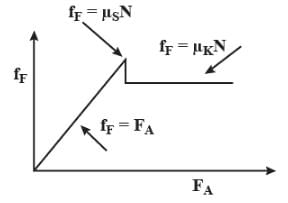
For a small value of the applied force the force of friction f increases linearly upto the limiting friction. When it crosses the maximum point of static friction then the friction force due to kinetic friction does not change any more.
A man weighs 70 kg. He stands on a weighing scale in a lift which is moving upwards with an acceleration of 5ms2.What would be the reading on the scale? (g=10 ms2)- a)1050 N
- b)1200 N
- c)220 N
- d)1000 N
Correct answer is option 'A'. Can you explain this answer?
A man weighs 70 kg. He stands on a weighing scale in a lift which is moving upwards with an acceleration of 5ms2.What would be the reading on the scale? (g=10 ms2)
a)
1050 N
b)
1200 N
c)
220 N
d)
1000 N
|
|
Arka Desai answered |
Given data:
Weight of man (W) = 70 kg
Acceleration of lift (a) = 5 m/s²
Acceleration due to gravity (g) = 10 m/s²
To find: Reading on the weighing scale
Explanation:
When the lift is moving upwards with an acceleration of 5 m/s², the man inside the lift will experience an apparent weight due to the net force acting on him. The apparent weight of the man will be greater than his actual weight when the lift is accelerating upwards, and will be less than his actual weight when the lift is decelerating or moving downwards.
The net force acting on the man can be calculated using Newton's second law of motion:
Net force (F) = ma, where m is the mass of the man and a is the acceleration of the lift.
The total force acting on the man is the sum of his actual weight and the net force:
Total force (T) = Weight of man (W) + Net force (F)
The reading on the weighing scale will be equal to the total force acting on the man.
Calculation:
Weight of man (W) = 70 kg × 10 m/s² = 700 N
Net force (F) = ma = 70 kg × 5 m/s² = 350 N
Total force (T) = W + F = 700 N + 350 N = 1050 N
Therefore, the reading on the weighing scale will be 1050 N.
Answer: a) 1050 N
Weight of man (W) = 70 kg
Acceleration of lift (a) = 5 m/s²
Acceleration due to gravity (g) = 10 m/s²
To find: Reading on the weighing scale
Explanation:
When the lift is moving upwards with an acceleration of 5 m/s², the man inside the lift will experience an apparent weight due to the net force acting on him. The apparent weight of the man will be greater than his actual weight when the lift is accelerating upwards, and will be less than his actual weight when the lift is decelerating or moving downwards.
The net force acting on the man can be calculated using Newton's second law of motion:
Net force (F) = ma, where m is the mass of the man and a is the acceleration of the lift.
The total force acting on the man is the sum of his actual weight and the net force:
Total force (T) = Weight of man (W) + Net force (F)
The reading on the weighing scale will be equal to the total force acting on the man.
Calculation:
Weight of man (W) = 70 kg × 10 m/s² = 700 N
Net force (F) = ma = 70 kg × 5 m/s² = 350 N
Total force (T) = W + F = 700 N + 350 N = 1050 N
Therefore, the reading on the weighing scale will be 1050 N.
Answer: a) 1050 N
A mass M is suspended by a rope from a rigid support at A as shown in figure. Another rope is tied at the end B, and it is pulled horizontally with a force F. If the rope AB makes an angle q with the vertical in equilibrium, then the tension in the string AB is : 
- a)F sin q
- b)F/sin q
- c)F cos q
- d)F/cos q
Correct answer is option 'B'. Can you explain this answer?
A mass M is suspended by a rope from a rigid support at A as shown in figure. Another rope is tied at the end B, and it is pulled horizontally with a force F. If the rope AB makes an angle q with the vertical in equilibrium, then the tension in the string AB is :
a)
F sin q
b)
F/sin q
c)
F cos q
d)
F/cos q
|
|
Neha Sharma answered |
As the block is still at the equilibrium, we get
T.cos q = mg
T.sin q = F
Thus we T = F / sin q
T.cos q = mg
T.sin q = F
Thus we T = F / sin q
A block of mass 2 kg is placed on the floor. The coefficient of static friction is 0.4. If a force of 2.8 N is applied on the block parallel to floor, the force of friction between the block and floor is (Take g = 10 m/s2) - a)2.8 N
- b)8 N
- c)2 N
- d)zero
Correct answer is option 'A'. Can you explain this answer?
A block of mass 2 kg is placed on the floor. The coefficient of static friction is 0.4. If a force of 2.8 N is applied on the block parallel to floor, the force of friction between the block and floor is (Take g = 10 m/s2)
a)
2.8 N
b)
8 N
c)
2 N
d)
zero
|
|
Geetika Shah answered |
Weight of the block is 20N thus maximum friction that can act is 0.4 x 20 = 8N
But as the external force acting, F = 2.8N < 8N,
We get f = F = 2.8N
But as the external force acting, F = 2.8N < 8N,
We get f = F = 2.8N
A constant force acting on a body of mass 3 kg changes its speed from 2 m/s to 3.5 m/s in 10 second. If the direction of motion of the body remains unchanged, what is the magnitude and direction of the force?- a)0.45 N in the direction opposite to motion.
- b)2.45 N in the direction of motion.
- c)0.45 N in the direction of motion.
- d)1.45 N in the direction opposite to motion.
Correct answer is 'C'. Can you explain this answer?
A constant force acting on a body of mass 3 kg changes its speed from 2 m/s to 3.5 m/s in 10 second. If the direction of motion of the body remains unchanged, what is the magnitude and direction of the force?
a)
0.45 N in the direction opposite to motion.
b)
2.45 N in the direction of motion.
c)
0.45 N in the direction of motion.
d)
1.45 N in the direction opposite to motion.
|
|
Nandini Patel answered |
Mass of the body, m = 3 kg
Initial speed of the body, u = 2 m/s
Final speed of the body, v = 3.5 m/s
Time, t = 10 s
Using the first equation of motion, the acceleration (a) produced in the body can be calculated as:
v = u + at
∴ a = (v – u) / t
= (3.5 – 2) / 10 = 0.15 ms^-2
As per Newton’s second law of motion, force is given as:
F = ma
= 3 x 0.15 = 0.45 N
Since the application of force does not change the direction of the body, the net force acting on the body is in the direction of its motion.
Velocity-time graph of the particle is- a)

- b)

- c)

- d)

Correct answer is option 'A'. Can you explain this answer?
Velocity-time graph of the particle is
a)
b)
c)
d)
|
|
Gaurav Kumar answered |
In the velocity time graph, the slope value should give the value of acceleration.
A particle of mass 50 gram moves on a straight line. The variation of speed with time is shown in figure. find the force acting on the particle at t = 2, 4 and 6 seconds. 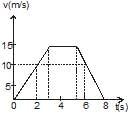
- a)0.25 N along motion, zero, 0.25 opposite to motion
- b)0.25 N along motion, zero, 0.25 along to motion
- c)0.25 N opposite motion, zero, 0.25 along to motion
- d)0.25 N opposite motion, zero, 0.25 opposite to motion
Correct answer is option 'A'. Can you explain this answer?
A particle of mass 50 gram moves on a straight line. The variation of speed with time is shown in figure. find the force acting on the particle at t = 2, 4 and 6 seconds.
a)
0.25 N along motion, zero, 0.25 opposite to motion
b)
0.25 N along motion, zero, 0.25 along to motion
c)
0.25 N opposite motion, zero, 0.25 along to motion
d)
0.25 N opposite motion, zero, 0.25 opposite to motion
|
|
Geetika Shah answered |
- To know the force acting on the particle, we need to know the acceleration of the particle. In the velocity-time graph the slope of the curve gives the instantaneous acceleration. Let us find it for the given instant.
- At t=2 seconds
The graph is a straight line with positive slope. It means the particle has a constant acceleration with magnitude =15/3 =5 m/s.
So the force acting on it = mass x acceleration = 0.05 kg x 5 m/s
= 0.25 N, it acts along the motion because it is positive. - At t=4 seconds
The graph is horizontal to time axis meaning thereby the velocity is constant and no acceleration. It can be understood in this way too that the slope which represents acceleration is zero. Since there is no acceleration at t=4 s. so there is no force acting on the particle at this instant, Force= zero. - At t=6 seconds
The graph shows that velocity is uniformly decreasing with the time and the acceleration which is represented by the slope is negative. From the graph value of acceleration = -15/3 =-5 m/s
Force = mass x acceleration = 0.05 x -5 N =-0.25 N - So the force acting on the particle is 0.25 N and negative sign shows that its direction is opposite to the motion.
The frictional force between two surfaces is independent of- a)nature of surface
- b)mass of the body
- c) area of contact
- d)None of these
Correct answer is option 'C'. Can you explain this answer?
The frictional force between two surfaces is independent of
a)
nature of surface
b)
mass of the body
c)
area of contact
d)
None of these
|
|
Krishna Iyer answered |
The frictional force between two surfaces 
where μs depends on the nature of surface and their materials. Thus, frictional force is independent of area of contact of the surfaces.
The pulley arrangements shown in figure are identical the mass of the rope being negligible. In case I, the mass m is lifted by attaching a mass 2m to the other end of the rope. In case II, the mass m is lifted by pulling the other end of the rope with cosntant downward force F = 2mg, where g is acceleration due to gravity. The acceleration of mass in case I is 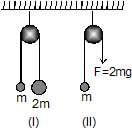
- a)Zero
- b)More than that in case II
- c) Less than that in case
- d)Equal to that in case II
Correct answer is option 'C'. Can you explain this answer?
The pulley arrangements shown in figure are identical the mass of the rope being negligible. In case I, the mass m is lifted by attaching a mass 2m to the other end of the rope. In case II, the mass m is lifted by pulling the other end of the rope with cosntant downward force F = 2mg, where g is acceleration due to gravity. The acceleration of mass in case I is
a)
Zero
b)
More than that in case II
c)
Less than that in case
d)
Equal to that in case II
|
|
Pooja Shah answered |
When we make the free body diagram of two mass system in case 1, we get the equation
2mg - mg = (2m + m) a
Thus we get a = g/3
But in the case 2 the equations is as follows
2mg - mg = ma
Thus we get a - g here.
2mg - mg = (2m + m) a
Thus we get a = g/3
But in the case 2 the equations is as follows
2mg - mg = ma
Thus we get a - g here.
A rope of mass 5 kg is moving vertically in vertical position with an upwards force of 100 N acting at the upper end and a downwards force of 70 N acting at the lower end. The tension at midpoint of the rope is- a)100 N
- b)85 N
- c)75 N
- d)105 N
Correct answer is option 'B'. Can you explain this answer?
A rope of mass 5 kg is moving vertically in vertical position with an upwards force of 100 N acting at the upper end and a downwards force of 70 N acting at the lower end. The tension at midpoint of the rope is
a)
100 N
b)
85 N
c)
75 N
d)
105 N
|
|
Anjana Sharma answered |
When you are given one upward and one downward force on a rope of some mass, and you have to find the tension at the mid- point, then you can simply average the 2 forces. So, the correct answer is (100+70)/3 = 85N
Which law says that every force is accompanied by an equal and opposite force?- a)Newton’s first law of motion
- b)Newton’s third law of motion
- c)law of inertia
- d)Newton’s second law of motion
Correct answer is option 'B'. Can you explain this answer?
Which law says that every force is accompanied by an equal and opposite force?
a)
Newton’s first law of motion
b)
Newton’s third law of motion
c)
law of inertia
d)
Newton’s second law of motion
|
|
Raghav Bansal answered |
"Every action has an equal and opposite reaction” -Newton's 3rd Law
In a tug-of-war contest, two men pull on a horizontal rope from opposite sides. The winner will be the man who- a)Exerts greater force on the rope
- b) Exerts greater force on the ground
- c)Exerts a force on the rope which is greater than the tension in the rope
- d) Makes a smaller angle with the vertical
Correct answer is option 'B'. Can you explain this answer?
In a tug-of-war contest, two men pull on a horizontal rope from opposite sides. The winner will be the man who
a)
Exerts greater force on the rope
b)
Exerts greater force on the ground
c)
Exerts a force on the rope which is greater than the tension in the rope
d)
Makes a smaller angle with the vertical
|
|
Naina Sharma answered |
The greater the force exerted on the ground, the greater is the reaction and therefore the greater pull will be given to the rope.
A man pulls a block heavier than himself with a light horizontal rope. The coefficient of friction is the same between the man and the ground, and between the block and the ground. 
- a)The block will not move unless the man also moves
- b)The man can move even when the block is stationary
- c)If both move, the acceleration of the man is greater than the acceleration of the block
- d)None of the above assertions is correct
Correct answer is option 'A,B,C'. Can you explain this answer?
A man pulls a block heavier than himself with a light horizontal rope. The coefficient of friction is the same between the man and the ground, and between the block and the ground.
a)
The block will not move unless the man also moves
b)
The man can move even when the block is stationary
c)
If both move, the acceleration of the man is greater than the acceleration of the block
d)
None of the above assertions is correct
|
|
Krishna Iyer answered |
The friction force between the block and ground is more as compared to friction force between man and ground.
such that unless man doesn't move the block will not be moved.
The block of mass say M is heavier than the man of mass say m. The surface is rough with friction coefficient say μ. So when the man applies the force on the block the force cannot exceed the frictional force μmg without moving as μMg>μmg. Now if he starts moving (i.e. the force applied is increased and now the friction between him and the surface is not holding him stationary) there is a possibility that the block may move. Now as there is no other force acting on the system and as the man is lighter than block so he would have greater acceleration than the block when both move.
such that unless man doesn't move the block will not be moved.
The block of mass say M is heavier than the man of mass say m. The surface is rough with friction coefficient say μ. So when the man applies the force on the block the force cannot exceed the frictional force μmg without moving as μMg>μmg. Now if he starts moving (i.e. the force applied is increased and now the friction between him and the surface is not holding him stationary) there is a possibility that the block may move. Now as there is no other force acting on the system and as the man is lighter than block so he would have greater acceleration than the block when both move.
A boy of mass 50 Kg running at 5 m/s jumps on to a 20Kg trolley travelling in the same direction at 1.5 m/s. What is the common velocity?- a)4m/s
- b)3 m/s
- c)3.5 m/s
- d)None of the above
Correct answer is option 'A'. Can you explain this answer?
A boy of mass 50 Kg running at 5 m/s jumps on to a 20Kg trolley travelling in the same direction at 1.5 m/s. What is the common velocity?
a)
4m/s
b)
3 m/s
c)
3.5 m/s
d)
None of the above
|
|
Naina Sharma answered |
Since no external force, law of conservation of momentum can be applied
Initial Momentum

Final momentum

where v is the common velocity
Now we know that
Initial momentum = Final momentum
280 = 70v
V = 4m/s
Initial Momentum

Final momentum

where v is the common velocity
Now we know that
Initial momentum = Final momentum
280 = 70v
V = 4m/s
Two bodies of mass 6 kg and 4 kg are tied to a string as shown in the adjoining figure. If the table is smooth and pulley frictionless, then acceleration of mass 6 kg will be (g = 10 m/s2)
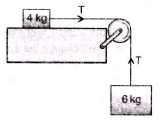
- a)60 m/s2
- b)40 m/s2
- c)6 m/s2
- d)4 m/s2
Correct answer is option 'C'. Can you explain this answer?
Two bodies of mass 6 kg and 4 kg are tied to a string as shown in the adjoining figure. If the table is smooth and pulley frictionless, then acceleration of mass 6 kg will be (g = 10 m/s2)
a)
60 m/s2
b)
40 m/s2
c)
6 m/s2
d)
4 m/s2
|
|
Ananya Singh answered |
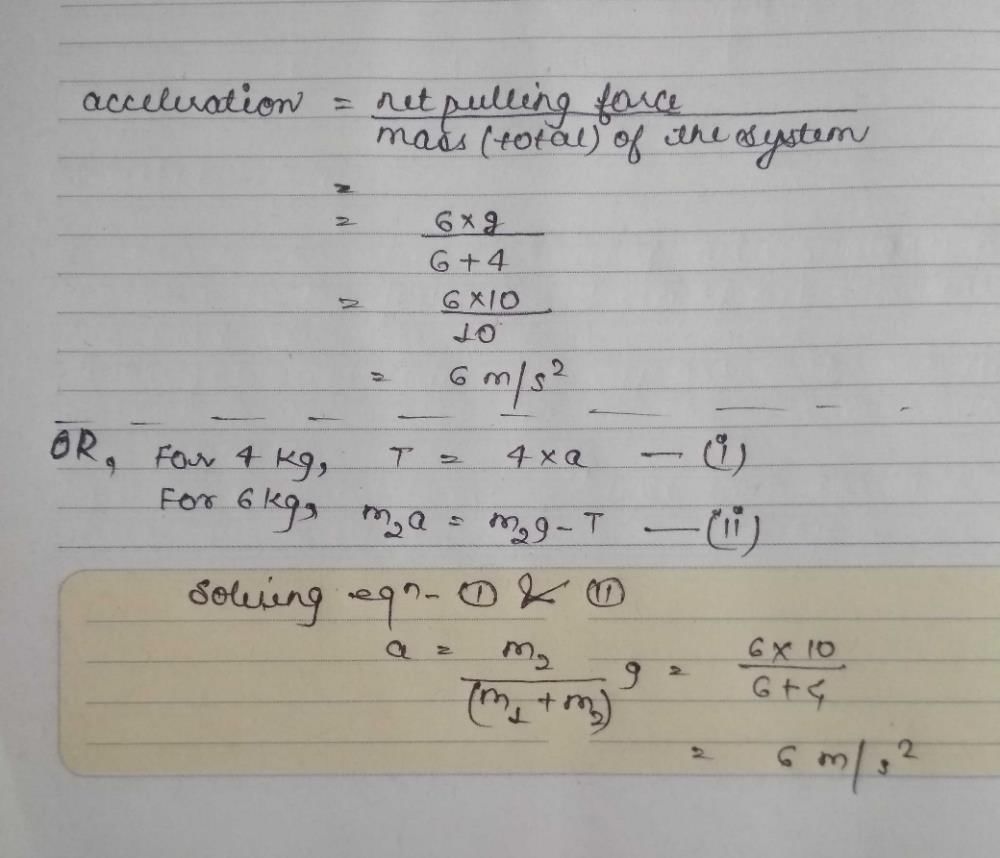
Three equal weights A, B, C of mass 2 kg each are hanging on a string passing over a fixed frictionless pulley as shown in the fig. The tension in the string connecting weights B and C is-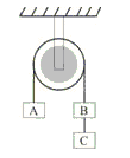
- a)Zero
- b) 13 Newton
- c)3.3 Newton
- d)19.6 Newton
Correct answer is option 'B'. Can you explain this answer?
Three equal weights A, B, C of mass 2 kg each are hanging on a string passing over a fixed frictionless pulley as shown in the fig. The tension in the string connecting weights B and C is-
a)
Zero
b)
13 Newton
c)
3.3 Newton
d)
19.6 Newton
|
|
Nandini Iyer answered |
For some time let us consider B and C to be one single block of mass 4kg. Now if we make the free body diagram for blocks A, B, C we get the net acceleration of the system by equation
4.g - 2.g = 6.a
Thus we get a = g/3
Now if we only make a F.B.D. of block C, we get
2.g - T = 2.a
Thus T = 2 (g - g/3)
= 4g/3
= 13.3 N
4.g - 2.g = 6.a
Thus we get a = g/3
Now if we only make a F.B.D. of block C, we get
2.g - T = 2.a
Thus T = 2 (g - g/3)
= 4g/3
= 13.3 N
A particle of mass M, originally at rest is subjected to a force whose direction is constant but whose magnitude varies with the time according to the relation

where F0 and T are constant. The force acts only for the time interval 2T. Find the velocity v of the particle after time 2T.
- a)F0/3M
- b)4F0/3M
- c)F0/2M
- d)none of the above
Correct answer is option 'B'. Can you explain this answer?
A particle of mass M, originally at rest is subjected to a force whose direction is constant but whose magnitude varies with the time according to the relation

where F0 and T are constant. The force acts only for the time interval 2T. Find the velocity v of the particle after time 2T.
where F0 and T are constant. The force acts only for the time interval 2T. Find the velocity v of the particle after time 2T.
a)
F0/3M
b)
4F0/3M
c)
F0/2M
d)
none of the above

|
R L Sharma answered |
I think this statement is said by Aristotle as every body is in the natural state of rest. and it get in the state of motion ony when some external force is applied on it.
Three blocks A, B and C are suspended as shown in the figure. Mass of each blocks A and C is m. If system is in equilibrium and mass of B is M, then : 
- a) M = 2m (
- b) M<2m
- c) M > 2m
- d) M = m
Correct answer is option 'B'. Can you explain this answer?
Three blocks A, B and C are suspended as shown in the figure. Mass of each blocks A and C is m. If system is in equilibrium and mass of B is M, then :
a)
M = 2m (
b)
M<2m
c)
M > 2m
d)
M = m
|
|
Pooja Shah answered |
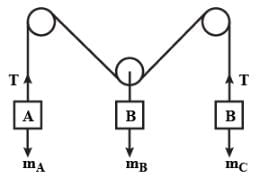
Given,
Mass of block A & B = m
Mass of block C = M
Let,
Mass of A = mA & Mass of B = mB
Tension in string is = T
At equilibrium, T = mAg = mBg = mg
Weight of block C is = Mg
Forces on block C,
2Tcosθ = Mgcosθ
⇒ Mg/2T = Mg/2mg
⇒ M/2m
If 0< θ <90° then 1> cosθ >0
1> M/2m >0
2m > M
Hence, 2m > M
A ball of mass 0.5 kg is attached to the end of a string having length 0.5 m. The hall is rotated on a horizontal circular path about vertical axis. The maximum tension that the string can bear is 324 N. The maximum possible value of angular velocity of ball in (rad/s) - a)9
- b)18
- c)27
- d)36
Correct answer is option 'D'. Can you explain this answer?
A ball of mass 0.5 kg is attached to the end of a string having length 0.5 m. The hall is rotated on a horizontal circular path about vertical axis. The maximum tension that the string can bear is 324 N. The maximum possible value of angular velocity of ball in (rad/s)
a)
9
b)
18
c)
27
d)
36
|
|
Pooja Kulkarni answered |
T sin θ = mrω2; r = l sin θ
A machine gun has a mass of 20 kg fires 35 g bullets at the rate of 400 bullets per second with a speed of 400ms-1 .What force must be applied to the gun to keep in the position?- a)5800 N
- b)5600 N
- c)560 N
- d)56 N
Correct answer is option 'B'. Can you explain this answer?
A machine gun has a mass of 20 kg fires 35 g bullets at the rate of 400 bullets per second with a speed of 400ms-1 .What force must be applied to the gun to keep in the position?
a)
5800 N
b)
5600 N
c)
560 N
d)
56 N
|
|
Geetika Shah answered |
To conserve the momentum each time a single bullet is fired,
the reverse speed gained by the gun from one bullet is
V = 400 X .035 / 20
= 0.7 m/s
Thus total speed gained in a second is = 0.7 X 400 = 280 m/s
As total speed is gained in one second only the acceleration produced = 280 m/s2
Thus total force applied on the gun by the bullets = 20 x 280
= 5600 N
the reverse speed gained by the gun from one bullet is
V = 400 X .035 / 20
= 0.7 m/s
Thus total speed gained in a second is = 0.7 X 400 = 280 m/s
As total speed is gained in one second only the acceleration produced = 280 m/s2
Thus total force applied on the gun by the bullets = 20 x 280
= 5600 N
A small coin is placed on a horizontal turn table. The turn table is observed to make three revolutions in 3.14 sec. What is the coefficient of static friction between the coin and turn table if the coin is observed to slide off the turn table when it is greater than 10 cm from the centre of the turn table - a)0.4
- b)0.04
- c)4
- d)0.004
Correct answer is option 'B'. Can you explain this answer?
A small coin is placed on a horizontal turn table. The turn table is observed to make three revolutions in 3.14 sec. What is the coefficient of static friction between the coin and turn table if the coin is observed to slide off the turn table when it is greater than 10 cm from the centre of the turn table
a)
0.4
b)
0.04
c)
4
d)
0.004
|
|
Om Desai answered |
F = ma
so a = 250/30
a = 8.34
now the result is 4mt/secsqure
so reduction is 4.34
friction force will b 4.34 ×30
F = 130.2 N
The forces acting on an object are shown in the fig. If the body moves horizontally at a constant speed of 5 m/s, then the values of the forces P and S are, respectively-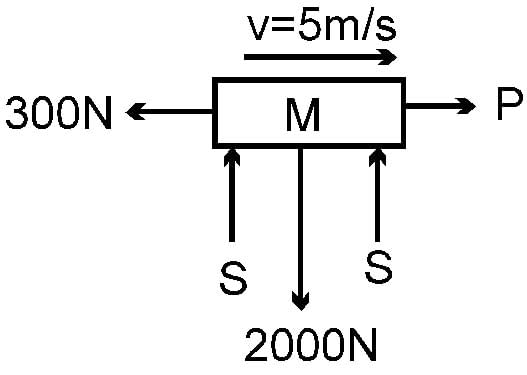
- a)0 N, 0 N
- b)300 N, 200 N
- c)300 N, 1000 N
- d)2000 N, 300 N
Correct answer is option 'C'. Can you explain this answer?
The forces acting on an object are shown in the fig. If the body moves horizontally at a constant speed of 5 m/s, then the values of the forces P and S are, respectively-
a)
0 N, 0 N
b)
300 N, 200 N
c)
300 N, 1000 N
d)
2000 N, 300 N
|
|
Naina Sharma answered |
As there is no net acceleration in horizontal or vertical direction, we can say that
P = 300N
And 2S = 2000N
Thus S = 1000N
P = 300N
And 2S = 2000N
Thus S = 1000N
A body of mass 8 kg is hanging another body of mass 12 kg. The combination is being pulled by a string with an acceleration of 2.2 m s-2. The tension T1 and T2 will be respectively : (use g = 9.8 m/s2) 
- a) 200 N, 80 N
- b)220 N, 90 N
- c) 240 N, 96 N
- d)260 N, 96 N
Correct answer is option 'C'. Can you explain this answer?
A body of mass 8 kg is hanging another body of mass 12 kg. The combination is being pulled by a string with an acceleration of 2.2 m s-2. The tension T1 and T2 will be respectively : (use g = 9.8 m/s2)
a)
200 N, 80 N
b)
220 N, 90 N
c)
240 N, 96 N
d)
260 N, 96 N

|
Top Rankers answered |
The tension T1 and T2 will be 240 N, 96 N.
Mass of the body = m1 = 12kg (Given)
Mass of the body = m2 = 8kg (Given)
Acceleration of the string - 2.2m/s² (Given)
Considering positive direction upwards -
Thus,
T1− (m1+m2)g = (m1+m2)a
T1 = (m1+m2)g + (m1+m2)a
T1= (12+8)(2.2)+(12+8)(9.8)
T1 = 44 + 196
= 240 N
T2− (m2)g=(m2)a
T2=(m2)g+(m2)a
T2= (8)(2.2)+(8)(9.8)
T2 = 17.6 + 78.4
= 96 N
Mass of the body = m1 = 12kg (Given)
Mass of the body = m2 = 8kg (Given)
Acceleration of the string - 2.2m/s² (Given)
Considering positive direction upwards -
Thus,
T1− (m1+m2)g = (m1+m2)a
T1 = (m1+m2)g + (m1+m2)a
T1= (12+8)(2.2)+(12+8)(9.8)
T1 = 44 + 196
= 240 N
T2− (m2)g=(m2)a
T2=(m2)g+(m2)a
T2= (8)(2.2)+(8)(9.8)
T2 = 17.6 + 78.4
= 96 N
At a given instant, A is moving with velocity of 5 m/s upwards. What is velocity of B at the time 
- a)6 m/s
- b)15 m/s
- c) 0 m/s
- d)None of these
Correct answer is option 'B'. Can you explain this answer?
At a given instant, A is moving with velocity of 5 m/s upwards. What is velocity of B at the time
a)
6 m/s
b)
15 m/s
c)
0 m/s
d)
None of these
|
|
Rajesh Gupta answered |
l1 = 2l2 + l3 = constant
dl1/dt + 2dl2/dt + dl3/dt = 0
−5 + 2(−5) + dl/dt = 0
dl3/dt = 15m/s
⇒ vB = 15m/s↓
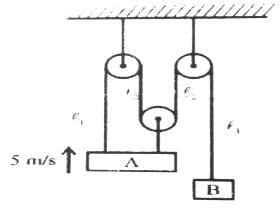
dl1/dt + 2dl2/dt + dl3/dt = 0
−5 + 2(−5) + dl/dt = 0
dl3/dt = 15m/s
⇒ vB = 15m/s↓

Chapter doubts & questions for Newton's Laws of Motion - Physics for JAMB 2025 is part of JAMB exam preparation. The chapters have been prepared according to the JAMB exam syllabus. The Chapter doubts & questions, notes, tests & MCQs are made for JAMB 2025 Exam. Find important definitions, questions, notes, meanings, examples, exercises, MCQs and online tests here.
Chapter doubts & questions of Newton's Laws of Motion - Physics for JAMB in English & Hindi are available as part of JAMB exam.
Download more important topics, notes, lectures and mock test series for JAMB Exam by signing up for free.
Physics for JAMB
259 videos|253 docs|230 tests
|

Contact Support
Our team is online on weekdays between 10 AM - 7 PM
Typical reply within 3 hours
|
Free Exam Preparation
at your Fingertips!
Access Free Study Material - Test Series, Structured Courses, Free Videos & Study Notes and Prepare for Your Exam With Ease

 Join the 10M+ students on EduRev
Join the 10M+ students on EduRev
|

|
Create your account for free
OR
Forgot Password
OR
Signup to see your scores
go up
within 7 days!
within 7 days!
Takes less than 10 seconds to signup


